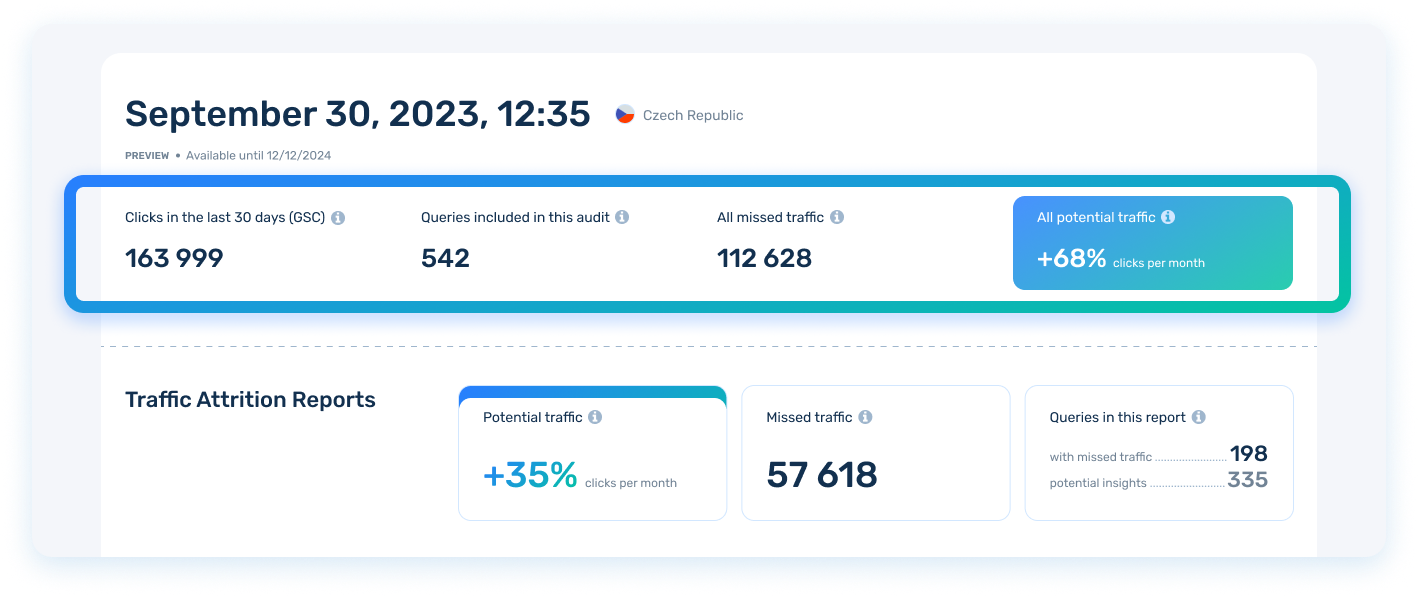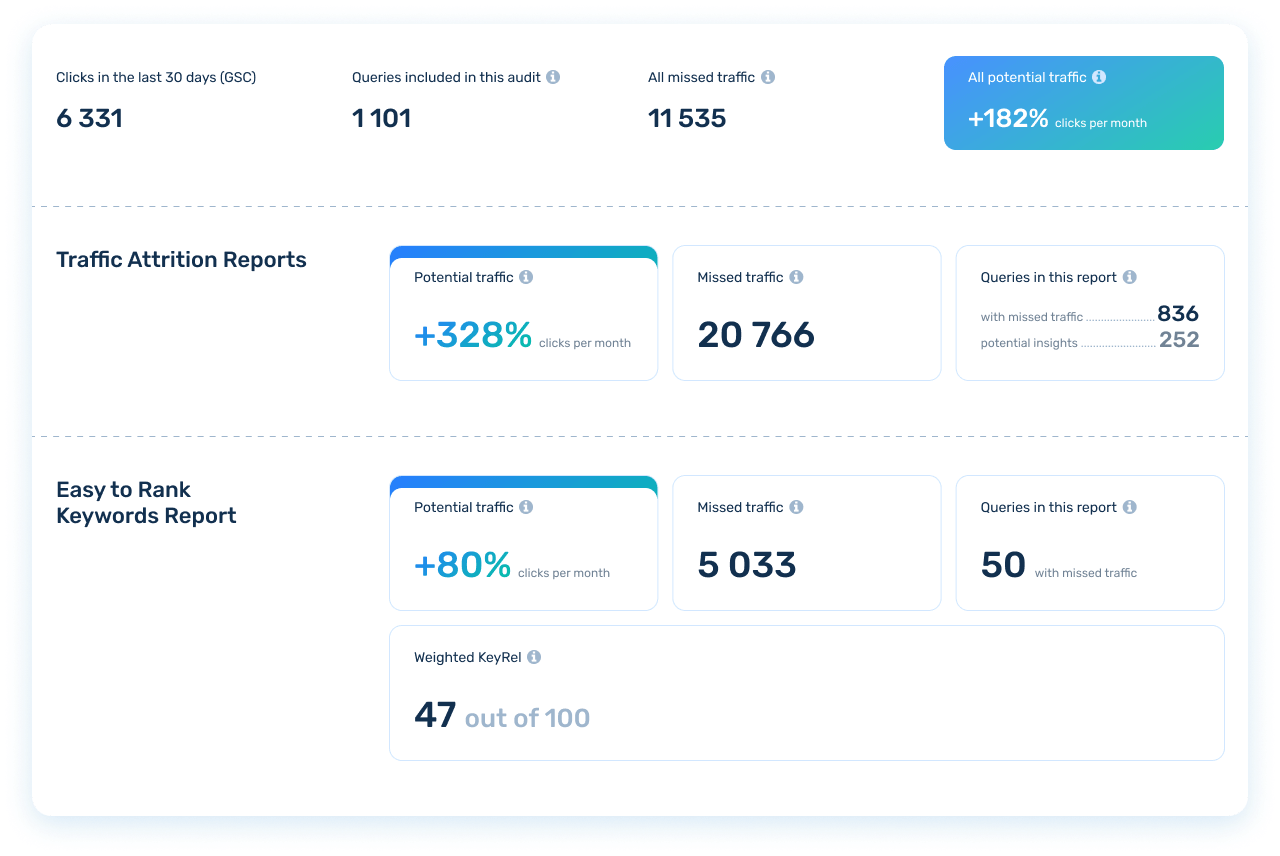How to Interpret Preview Metrics and Decide If You Should Use Your Credits for a Full Audit
When it comes to optimizing your website’s performance, SEO Analytics Reports audit preview offers a quick snapshot of your site’s strengths and areas for improvement. But how do you make sense of these preview metrics, and when should you invest your credits in a full audit?
In this guide, we’ll break down the key metrics in SEO Analytics Reports preview report, show you how to interpret the data, and help you decide if using your credits for a comprehensive audit is the right move for your site’s growth. With Buddler’s credit system, you can make informed decisions, maximizing the value of your credits—whether you’re a new user exploring a 7-day trial with 75 credits or an existing user planning for the best ROI.
1. Overview of Key Metrics
The audit preview displays four essential metrics:
Clicks in the Last 30 Days (GSC): Reflects recent traffic data from Google Search Console.
Queries Included in this audit: Shows the number of search queries analyzed in the preview.
All Missed Traffic: Estimates the traffic your site may be missing due to content that is underperforming or unoptimized.
All Potential Traffic: Forecasts the additional traffic you could gain by implementing the suggested improvements.

These metrics give you a snapshot of your site’s current performance and potential growth areas. For more details on how these figures are calculated, check our tutorial, which also includes tips and bonus insights.
Buddler’s forecasts are intentionally conservative, focusing on realistic traffic gains rather than inflated numbers. We only include traffic that we believe can be profitable for your site, avoiding low-value or speculative queries. It’s crucial to evaluate the metrics together to get a complete picture of your site’s potential rather than looking at each one in isolation.
2. When to Use Your Credits for a Full Audit
Deciding whether to spend your credits on a full audit depends on your site’s current performance and needs. Here are five scenarios to help guide your choice:
These cases highlight common situations that may affect your site’s data analysis. Let’s go through each one to understand why it could be beneficial to initiate a full audit or address the underlying issues.
Case 1: High Potential Traffic Figures

If your audit preview shows high potential traffic, it often indicates a decline in your site’s recent organic traffic. This could be due to drops in search rankings or significant changes on your site, such as updates to your products or content. In this situation, using 40 credits for a full audit can help you identify the affected queries and provide strategies for regaining lost traffic. A high number of queries with missed traffic suggests widespread declines, making a full audit particularly beneficial.
Case 2: Low or Zero Traffic Opportunity

If the preview shows low or zero potential traffic, it may be because there isn’t enough data for a thorough analysis. This is common for new or low-traffic sites. Alternatively, it could mean your site is already performing well with minimal missed traffic. In this case, using your credits might not be necessary right now. However, it’s worth considering a full audit in the future as your site’s traffic grows. Additionally, if your site relies on event-based or seasonal queries, the patterns might not be obvious in the current data, making it harder to assess the opportunity fully.
Case 3: Discrepancies Between Reports

You might notice differences in potential traffic estimates across various reports. This is normal, as each report uses distinct analysis methods and focuses on different aspects of your site’s data. Instead of fixating on exact numbers, consider the overall trends and what they reveal about your site’s potential. If the general outlook is positive, using your credits for a full audit can help you dive deeper and identify specific opportunities.
Case 4: Incomplete Audit Due to Technical Errors

Occasionally, an audit may be incomplete due to technical issues. For instance, if your site’s structure prevents us from scraping content effectively, the “Easy to Rank Keywords” report might not be generated. Similarly, insufficient data from Google Search Console can affect the “Traffic Attrition” report.
In some cases, these errors are temporary, and rerunning the audit after 24 hours might resolve the issue. However, certain limitations, like unsupported languages for specific reports, are permanent. If an error persists, evaluate the potential of the available report before deciding to use your credits. If you believe both reports should be included but continue to encounter errors, reach out to our support team for assistance. We can help determine whether a complete audit is possible.
Case 5: Duplicate Results from Domain Resource and Main Site Version

You may find that the audit results are identical for both the domain resource and the main site version. This usually happens when both versions share the same data history in Google Search Console. However, if the versions differ, such as a specific folder or section with distinct content, the results may vary, offering separate insights.
If the data is the same, there’s no need to use your credits on both versions. Choose the one that covers your main area of interest. If the data differs and you want to analyze separate sections independently, using your credits for audits of both versions might be worthwhile.
3. Making the Decision: Key Takeaways
When deciding whether to use your credits for a full audit, consider the metrics as a whole rather than focusing on individual figures. High potential traffic estimates can be promising, but it’s important to weigh them against your site’s current performance. If you believe that even a fraction of the predicted traffic gains could be realized with minimal effort, using your credits for a full audit can provide a detailed action plan. If the metrics seem less compelling, there’s no pressure to proceed, and you can always save your credits for future use.
4. Conclusion: Revisiting the Audit in the Future
Your site’s data and performance can change over time, so it’s okay if you’re not ready to use your credits for a full audit now. As you gather more traffic data or update your site, new opportunities may arise. Buddler’s free trial offers 75 credits, enough for one full audit, allowing you to experience the benefits without any upfront commitment. After the trial, you can purchase a plan with credits that are valid for 30 days, giving you flexibility to run full audits when needed.
Remember, the preview is designed to give you a snapshot of your current potential, so feel free to revisit the audit later as your site’s needs evolve.